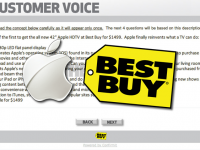This Apple television speculation analysis examines a Best Buy customer survey that detailed specific rumored specs for Apple's anticipated HDTV product, including 42-inch 1080p display, iOS connection, App Store features, iCloud synchronization, and FaceTime features at a premium $1,499 price point. Patrick Bisch evaluates the survey's unusual specificity regarding features like iSight camera connection, Skype compatibility, and AirPlay features while questioning the authenticity and strategic purpose of retail-initiated market research during the peak period of Apple TV rumors. The coverage captures the intersection of retail intelligence gathering, consumer expectation management, and technology journalism's role in analyzing unofficial product disclosure through third-party sources.
The specification analysis covers the rumored 42-inch LED display with 1080p resolution, iOS operating system connection that would transform television into an oversized iPad, App Store features enabling third-party application installation, and iCloud connectivity for seamless media access across Apple device ecosystems. The feature evaluation details built-in FaceTime camera and microphone features, iPhone and iPad remote control connection through AirPlay, and support for popular streaming services including Netflix, YouTube, and Flickr that would position the device as a complete entertainment hub. The pricing assessment examines the $1,499 retail cost that importantly exceeded contemporary television pricing while reflecting Apple's premium positioning strategy.
The strategic implications evaluation encompasses Best Buy's market research motivations during the period when Apple television rumors dominated consumer electronics speculation and retail preparation strategies. The authenticity assessment covers the Norwegian research company Confirmit's involvement, Best Buy's historical relationship with third-party survey providers, and the unusual specificity of technical details that suggested either insider knowledge or sophisticated speculation. The competitive positioning analysis examines how Apple's television ambitions would challenge established players like Samsung, LG, and Sony while extending Apple's ecosystem connection strategy into the living room entertainment category.
This Best Buy Apple TV survey represents the peak period of television industry disruption speculation when Apple's success with phones generated widespread expectations for complete entertainment ecosystem expansion. Looking back 13+ years later, many predicted features became reality through the Apple TV set-top box evolution rather than dedicated television hardware, validating the core vision while avoiding the challenging television manufacturing market dominated by established players. The iOS connection concept documented anticipated the development of tvOS that powers modern Apple TV devices, providing app store features and ecosystem connection without requiring Apple to manufacture display hardware. The iCloud media synchronization highlighted proved prescient as streaming services and cloud storage became standard television features across all manufacturers, eliminating the need for proprietary media ecosystem connection. The FaceTime camera connection suggested anticipated the rise of video calling through televisions that later materialized through smart TV platforms, webcam accessories, and streaming device attachments that provide similar features without built-in hardware needs. The premium pricing strategy indicated reflected Apple's approach to new product categories that prioritize margin and positioning over market share, though the television market's price sensitivity and upgrade cycles proved incompatible with Apple's typical premium positioning success. The retail intelligence gathering documented became standard practice for consumer electronics preparation as retailers developed sophisticated market research features to anticipate demand and inventory needs for highly anticipated product launches. This moment captures the transitional period when technology companies evaluated television market entry strategies before concluding that streaming devices and software platforms offered superior business models compared to hardware manufacturing in the highly competitive and low-margin television display market.
This summary was created by Dave Rogers. The original post was written by Patrick Bisch and published on February 1, 2012.
If you'd like to view the original post, you can find it here.
